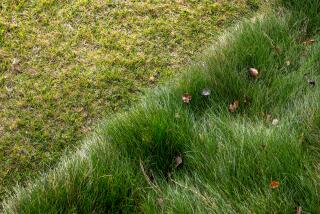Many Plants Can Weather Wind, Salt
- Share via
Question: What plants do well along the coast?
S.T., Huntington Beach
Answer: Gardening along the coast has its special challenges, including salt spray and windy conditions. Salt is extremely corrosive and many plants won’t tolerate the salt air, which results in salt burn.
Burned leaf tips are an indication of too much salt.
There are plants, however, that tolerate very salty air such as the aptly named saltbush (Atriplex). Many are desert plants and have a high resistance to salinity and alkalinity.
Windy conditions are also a problem on the coast. Plants that tolerate wind have small and/or waxy leaves that prevent the wind and salt air from damaging them and are able to reduce the rate at which they lose water.
Purchasing plants from a coastal nursery is advised, as these nurseries carry plants adapted for beach living.
It’s also best to start with small plants as they will adapt more readily to beach life than larger plants.
The following plants grow well on the coast, standing up to salt spray and windy conditions.
Grasses
(These grasses are salt resistant, but very invasive and should be contained within borders.)
* Bermuda
* Kikuyu
Perennials
* Agapanthus (Lily of the Nile): salt tolerant
* Armeria (Sea pink)
* Artemisia: salt tolerant
* Asters
* Baccharis (Coyote brush)
* Calocephalus Brownii (Cushion bush)
* California poppy
* Capeweed (Arctotheca calendula)
* Cymbidium
* Dusty miller
* Echium: salt and wind tolerant
* Gazania
* Geraniums
* Ice plant such as Carpobrotus, Drosanthemum and Lampranthus: may be invasive
* Jade plant
* Lamb’s ears: salt tolerant
* Lavender: salt tolerant
* Lupines: salt tolerant
* Penstemon: salt tolerant
* Salvia: salt tolerant
* Santolina
* Sea lavender (Limonium/Statice)
* Succulents such as Aloe, Cotyledons, Echeveria elegans (hen and chicks), Euphorbia: stand up to windy conditions
Trees and Shrubs
* Acacia longifolia and redolens: good wind breaks
* Arbutus unedo (strawberry tree)
* Artemisia
* Bottlebrush (Callistemon)
* Carissa
* Cape honeysuckle (Tecomaria capensis)
* Ceanothus (wild lilac)
* Cistus
* Cotoneaster
* Escallonia
* Meyer lemon
* Laurus nobilis
* Leptospermum laevigatum, scoparium: good wind breaks, salt retardant
* Manzanita
* Melaleuca nesophila: wind and salt spray tolerant
* Monterey cypress: good wind break
* Myoporum laetum: good wind break
* New Zealand Christmas tree (Metrosideros excelsus)
* Oleander
* Pittosporum: good wind break
* Rhaphiolepis
* Rosemary: salt resistant
* Roses (some varieties)
* Saltbush (Atriplex)
* Westringia rosmariniformis
Vegetables and Fruits
* Apple (Gordon and Beverly Hills only)
* Artichokes
* Bush beans
* Blackberries
* Broccoli
* Brussels sprouts
* Cauliflower
* Culinary herbs
* Leafy vegetables such as lettuce, spinach, Swiss chard, mustard, kale, endive, arugula, cabbage
* Peach
* Pumpkins
* Raspberries
* Root crops such as beets, carrots, garlic, onions, potatoes
* Sugar snap peas
* Sunflowers
* Strawberries
* Tomatoes (varieties developed for cool and foggy areas)
* Zucchini
Vines
* Bougainvillea
* Hardenbergia
* Honeysuckle
* Ivy
* Jasmine
* Lantana
* Passion
* Potato vine (Solanum jasminoides)
* Sweet peas (flowering): susceptible to mildew
* Trumpet vine
Have a problem in your yard? University of California Cooperative Extension (UCCE) Master Gardeners are here to help. These trained and certified horticultural volunteers are dedicated to extending research-based, scientifically accurate information to the public about home horticulture and pest management. They are involved with a variety of outreach programs, including the UCCE Master Garden hotline, which provides answers to specific questions. You can reach the hotline at (714) 708-1646 or send e-mail to ucmastergardeners @yahoo.com. Calls and e-mail are generally returned within two to three days.






